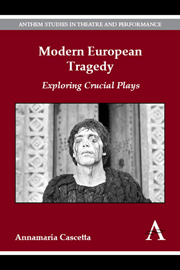Book contents
- Frontmatter
- Dedication
- Contents
- Acknowledgements
- Introduction: The Tragic, Tragedy and the Idea of the Limit
- Chapter 1 Hubris and Guilt: Gengangere (Ghosts)
- Chapter 2 Eve Becomes Mary: L'annonce faite à Marie (The Tidings Brought to Mary)
- Chapter 3 The School of Hatred: Mourning Becomes Electra
- Chapter 4 The Destiny of Man Is Man: Mutter Courage und ihre Kinder (Mother Courage and Her Children)
- Chapter 5 The Tragic and the Absurd: Caligula
- Chapter 6 Dianoetic Laughter in Tragedy: Accepting Finitude: Endgame
- Chapter 7 The Arrogance of Reason and the ‘Disappearance of the Fireflies’: Pilade (Pylades)
- Chapter 8 The Apocalypse of a Civilization: From Akropolis to Apocalypsis cum figuris
- A Provisional Epilogue: Between the Experience and the Representation of the Tragic: Towards a Performative Theatre
- Appendix: Chronology of Productions
- Notes
- Index
Chapter 3 - The School of Hatred: Mourning Becomes Electra
Published online by Cambridge University Press: 05 September 2014
- Frontmatter
- Dedication
- Contents
- Acknowledgements
- Introduction: The Tragic, Tragedy and the Idea of the Limit
- Chapter 1 Hubris and Guilt: Gengangere (Ghosts)
- Chapter 2 Eve Becomes Mary: L'annonce faite à Marie (The Tidings Brought to Mary)
- Chapter 3 The School of Hatred: Mourning Becomes Electra
- Chapter 4 The Destiny of Man Is Man: Mutter Courage und ihre Kinder (Mother Courage and Her Children)
- Chapter 5 The Tragic and the Absurd: Caligula
- Chapter 6 Dianoetic Laughter in Tragedy: Accepting Finitude: Endgame
- Chapter 7 The Arrogance of Reason and the ‘Disappearance of the Fireflies’: Pilade (Pylades)
- Chapter 8 The Apocalypse of a Civilization: From Akropolis to Apocalypsis cum figuris
- A Provisional Epilogue: Between the Experience and the Representation of the Tragic: Towards a Performative Theatre
- Appendix: Chronology of Productions
- Notes
- Index
Summary
In Europe, Thinking of the New Broadway
It will hardly appear surprising that a selection of the key texts of European twentieth-century drama should include a work by Eugene O'Neill, being yet another response to the emergence of the twentieth century's tragic consciousness. Of course he was American, but the matrix of his work is deeply rooted in European culture and theatrical research, with a pessimistic anthropology and a probing of behaviour based on depth psychology (one of the major axes of twentieth-century thought), embedded in a formal structure that is original and innovative compared to the currents of commercial Broadway theatre.
The idea of the limit is here based on the network of familial dynamics, on the affective block caused by the pathological development of the personality, on the condition of solitude of an individual closed to others. The tragic action is configured as a grave transgression driven by blindness and induced by hatred, one face of the evil that lurks in humans and pervades their lives and histories.
O'Neill began writing Mourning Becomes Electra in France in October 1929. He worked for several months with stubborn concentration and completed the first draft in February 1930. On returning to the text, after a holiday in Italy, he accentuated its nonrealistic structure by introducing asides and masks and highlighting the symbolic choice through the central and emblematic collocation of the shipboard scene and the theme song Shenandoah. By mid-July 1930 the second draft was ready.
- Type
- Chapter
- Information
- Modern European TragedyExploring Crucial Plays, pp. 47 - 58Publisher: Anthem PressPrint publication year: 2014

